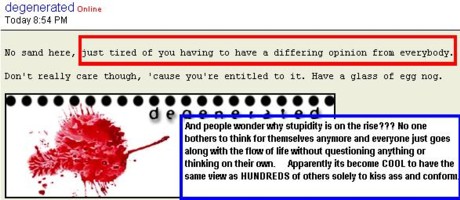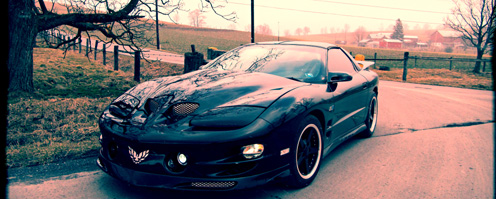Well sometimes when i accelerate hard my car pulls really hard left. then when i'm braking i'm getting a pull to the right. had the wheels off a while back and the calipers looked fine, pad wear seems even. then notice on my left front the lower boot had some grease that was leaking out and was spraying it over the inside of my fender?? any ideas.
-Z
Our differentials arn't positraction. It will spin 1 wheel all day, unless you are in gravel or a wed road thats PERFECTY level.
1971 camaro 427 --- here!

Stock... and loving every minute of it.
axle may be the problem....
fix where the leak is comming from and you'll prob fix the problem.

2.2L ECOTEC wrote:Our differentials arn't positraction. It will spin 1 wheel all day, unless you are in gravel or a wed road thats PERFECTY level.
This is true, but in cases where there aren't traction problems, he shouldn't have the pulling issues he's talking about.
Listen to Event and fix your issues before anything else.

what you have when you accelerate hard is called torque steer, all cars have it to a certain point

Technically, isn't torque steer the term associated with the twisting of the body that results from the power of a big engine torquing the whole car and putting more traction on one side? This happens even with an LSD.
This doesn't happen with a transverse mounted FWD setup.
Or maybe I'm thinking of something else...
On our cars, any pull would be associated with slip from the open diff and solved with an LSD.

probably need new outer tie rods

"torque steer (and steering "pull")
there are many reasons why a driver may experience steering "pull," that is, the need to apply a torque to the steering hand wheel so that the car will maintain a straight line. reasons include steering and suspension kinematic and compliance effects, influence of road camber, and interaction of asymmetric weight distributions with suspension geometry, wide separation between the thrust line and the vehicle longitudinal axis, tire characteristics, and, for frount-wheel drive cars, the interaction of drive torqe with driveshaft and steering geometries. the term torque steer is usually confined to describe the latter interaction. with a powerful frontdrive car, thsi interation may cause considerable disturbances to the steering and to the directional stability of the vehicle. typically, the car may tend to veer in one direction when acceleration hard and in the opposite direction when the engine power is suddenly reduced. when traversing, and particularly when accelerating, over a very uneven surface, the pull on the steering wheel may alternate rapidly in direction." this is in the book car suspension and hanling forth edition buy donald basow, geoffrey howard, and john p. whitehead.
in short with frount-wheel drive cars this is comon but if the problem was getting worse than usual then look at your suspension and drive trane and see if you see anything different (like you did and you seen a tare in the frunt driver side boots, top and bottom) this might be adding to the torque steer. i asume you have the stock diff and that contributes to the problem more than you beleve.
i didnt hit enough conez

this also includes alignments, if you got a more sporting alignment on the care (toe out in the front and positive camber) that would affect the "torque steer" of the car as well.
i didnt hit enough conez

So what was I talking about then? What do you call it when the torque of the engine is twisting a RWD car and causing it to pull to one side?

fix the axle and have your allignment checked . then we can go from there
Wild Weasel
So what was I talking about then? What do you call it when the torque of the engine is twisting a RWD car and causing it to pull to one side?
we are talking about the same thing. in a open differential most of the power is evenly distributed through out the two drive wheals, unless there is uneven ground (all roads are slanted a bit for ran runoff ) or the difference in the two drive tires(one tire slightly smaller than the other (not measurable buy a tape measure), differences in air pressures (buy one psi) or the actual toe or camber) also if one joint is more worn than the other.
that is why in high powered drag cars they have locking differentials and some people in local comp have there differential splines welded together so there was the same exact power and torque going to both sides of the drive wheals.
now if you were referring to the engine moving in the the mounts and the drive shaft with the diff at the end in a rear drive car. that is the sprung weight of the drive system. in old f body cars and some mustangs for instance lost allot of the power that the the engine put out in the drive system due to the weight that had to spin before the tiers moved. any engine mount cant stop all of the movement.
i was saying it happens in front wheel drive applications also. and with the quote from the book that is so people don't jump down my neck for being new to the forum

. i am a firm believer in hard evidence to reduce as much petty arguing that ruins some forums.
just my 2cents
i didnt hit enough conez

Torque Steer is twisting of the frame or suspension due to the high torque on opposite ends of the car. It is much more prevelant in RWD vehicles, but FWD can experience it to a limited extent.
Differiential Slip is the uneven distribution of power to different wheels. It is not called torque steer. This is more prevelant in FWD vehicles because almost all modern FWD vehicles have caster, when one wheel pulls harder it will pull that wheel around. This is due to the plane the wheel turns on (left and rigth, not arround) is not perpendicular to the plane of travel (forward/backward); it's off by about 3.5* on our cars (this adds forward stability and is not considered a bad thing, usually).
As I stated, the side effect of this non-perfect perpendicularity is that the car will naturally turn if the power distributed to each wheel is not perfect. Thus Differiential Slip --> Pulling to one side.
The pratical implementation is extremely obvious to anyone who has turfed someone in a FWD vehicle. One wheel will grab more turf than the other, and the car will pull very hard to that side.
LSDs will improve this problem, but because they only limit the slip (not eliminate it) they will only curb the problem, not eliminate it.
Back to the topic: Fix any obvious problems, then we'll work on any additional symptoms after.

It is 1WD. Get the pahntom grip and eliminate that problem.
I'll have a sig someday....................






